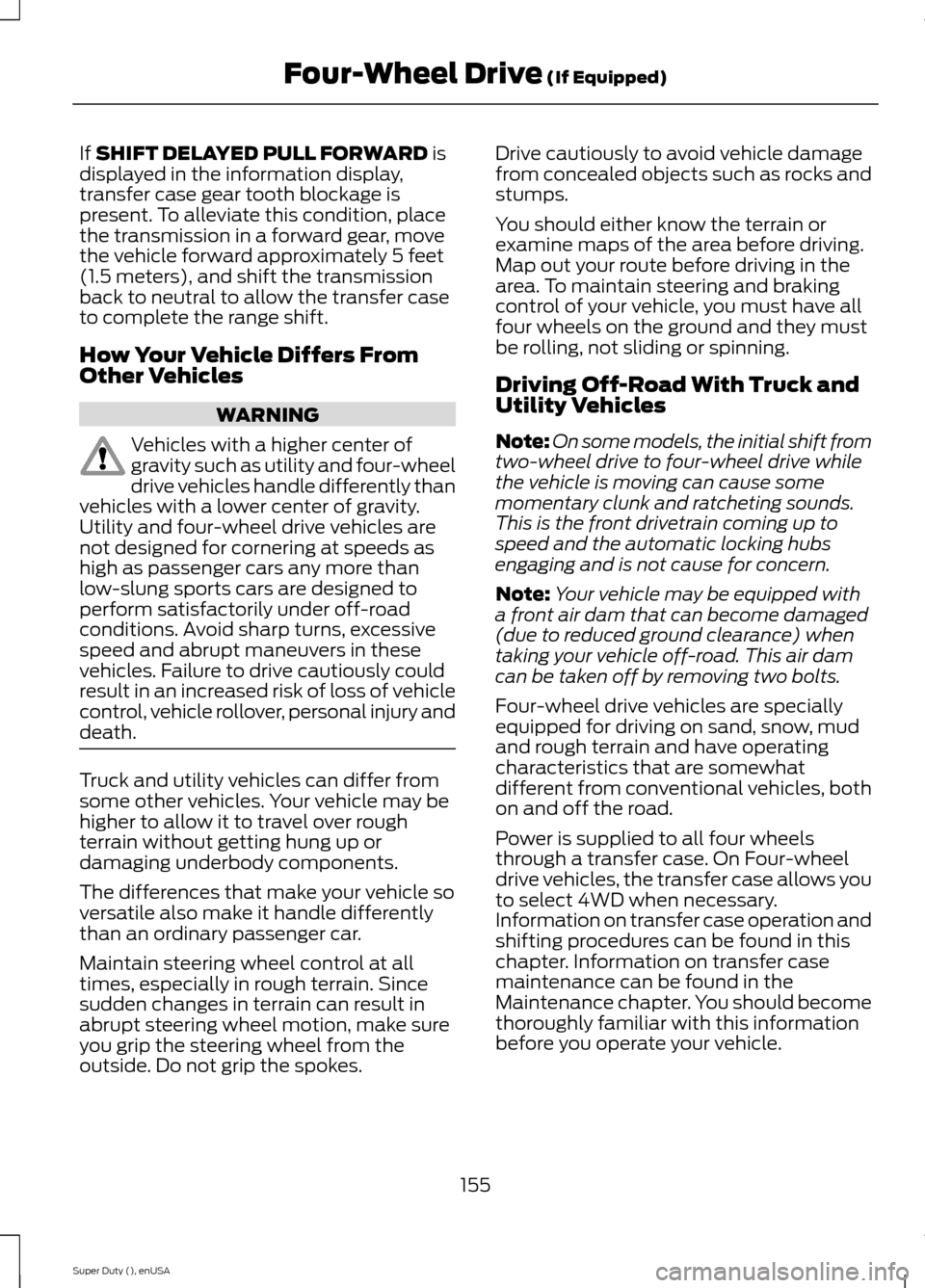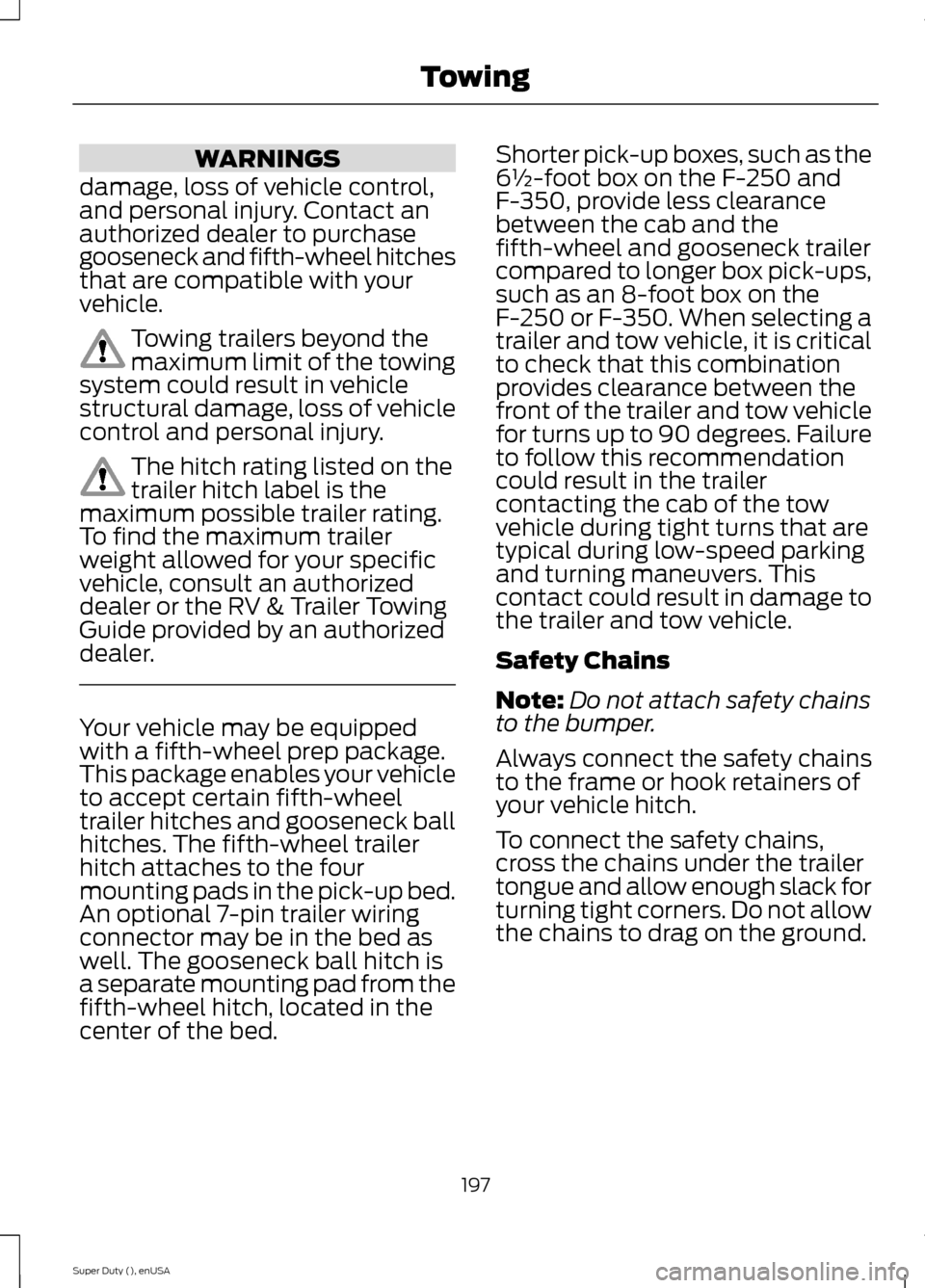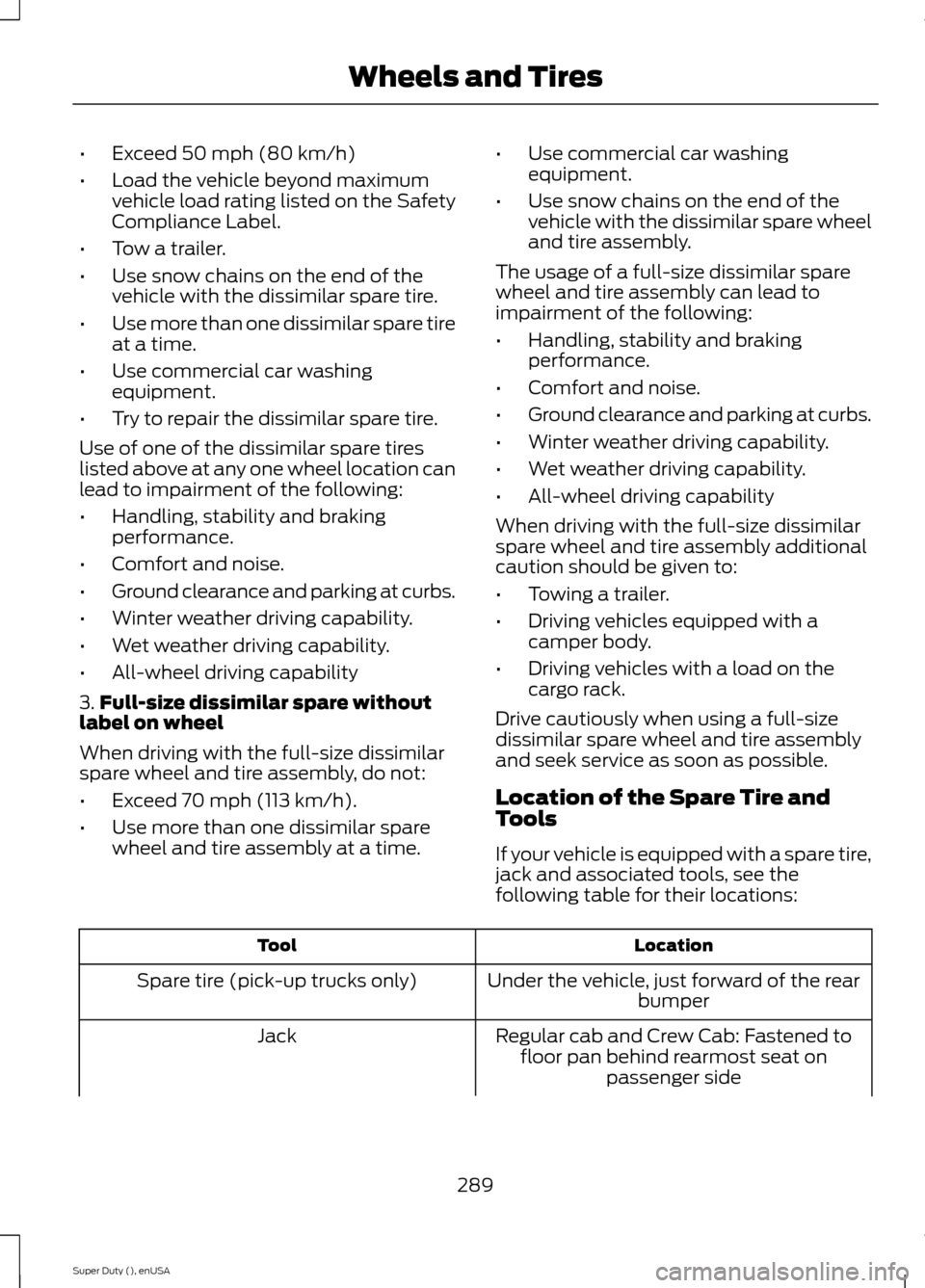2015 FORD SUPER DUTY ground clearance
[x] Cancel search: ground clearancePage 158 of 470

If SHIFT DELAYED PULL FORWARD isdisplayed in the information display,transfer case gear tooth blockage ispresent. To alleviate this condition, placethe transmission in a forward gear, movethe vehicle forward approximately 5 feet(1.5 meters), and shift the transmissionback to neutral to allow the transfer caseto complete the range shift.
How Your Vehicle Differs FromOther Vehicles
WARNING
Vehicles with a higher center ofgravity such as utility and four-wheeldrive vehicles handle differently thanvehicles with a lower center of gravity.Utility and four-wheel drive vehicles arenot designed for cornering at speeds ashigh as passenger cars any more thanlow-slung sports cars are designed toperform satisfactorily under off-roadconditions. Avoid sharp turns, excessivespeed and abrupt maneuvers in thesevehicles. Failure to drive cautiously couldresult in an increased risk of loss of vehiclecontrol, vehicle rollover, personal injury anddeath.
Truck and utility vehicles can differ fromsome other vehicles. Your vehicle may behigher to allow it to travel over roughterrain without getting hung up ordamaging underbody components.
The differences that make your vehicle soversatile also make it handle differentlythan an ordinary passenger car.
Maintain steering wheel control at alltimes, especially in rough terrain. Sincesudden changes in terrain can result inabrupt steering wheel motion, make sureyou grip the steering wheel from theoutside. Do not grip the spokes.
Drive cautiously to avoid vehicle damagefrom concealed objects such as rocks andstumps.
You should either know the terrain orexamine maps of the area before driving.Map out your route before driving in thearea. To maintain steering and brakingcontrol of your vehicle, you must have allfour wheels on the ground and they mustbe rolling, not sliding or spinning.
Driving Off-Road With Truck andUtility Vehicles
Note:On some models, the initial shift fromtwo-wheel drive to four-wheel drive whilethe vehicle is moving can cause somemomentary clunk and ratcheting sounds.This is the front drivetrain coming up tospeed and the automatic locking hubsengaging and is not cause for concern.
Note:Your vehicle may be equipped witha front air dam that can become damaged(due to reduced ground clearance) whentaking your vehicle off-road. This air damcan be taken off by removing two bolts.
Four-wheel drive vehicles are speciallyequipped for driving on sand, snow, mudand rough terrain and have operatingcharacteristics that are somewhatdifferent from conventional vehicles, bothon and off the road.
Power is supplied to all four wheelsthrough a transfer case. On Four-wheeldrive vehicles, the transfer case allows youto select 4WD when necessary.Information on transfer case operation andshifting procedures can be found in thischapter. Information on transfer casemaintenance can be found in theMaintenance chapter. You should becomethoroughly familiar with this informationbefore you operate your vehicle.
155Super Duty (), enUSAFour-Wheel Drive (If Equipped)
Page 200 of 470

WARNINGS
damage, loss of vehicle control,and personal injury. Contact anauthorized dealer to purchasegooseneck and fifth-wheel hitchesthat are compatible with yourvehicle.
Towing trailers beyond themaximum limit of the towingsystem could result in vehiclestructural damage, loss of vehiclecontrol and personal injury.
The hitch rating listed on thetrailer hitch label is themaximum possible trailer rating.To find the maximum trailerweight allowed for your specificvehicle, consult an authorizeddealer or the RV & Trailer TowingGuide provided by an authorizeddealer.
Your vehicle may be equippedwith a fifth-wheel prep package.This package enables your vehicleto accept certain fifth-wheeltrailer hitches and gooseneck ballhitches. The fifth-wheel trailerhitch attaches to the fourmounting pads in the pick-up bed.An optional 7-pin trailer wiringconnector may be in the bed aswell. The gooseneck ball hitch isa separate mounting pad from thefifth-wheel hitch, located in thecenter of the bed.
Shorter pick-up boxes, such as the6½-foot box on the F-250 andF-350, provide less clearancebetween the cab and thefifth-wheel and gooseneck trailercompared to longer box pick-ups,such as an 8-foot box on theF-250 or F-350. When selecting atrailer and tow vehicle, it is criticalto check that this combinationprovides clearance between thefront of the trailer and tow vehiclefor turns up to 90 degrees. Failureto follow this recommendationcould result in the trailercontacting the cab of the towvehicle during tight turns that aretypical during low-speed parkingand turning maneuvers. Thiscontact could result in damage tothe trailer and tow vehicle.
Safety Chains
Note:Do not attach safety chainsto the bumper.
Always connect the safety chainsto the frame or hook retainers ofyour vehicle hitch.
To connect the safety chains,cross the chains under the trailertongue and allow enough slack forturning tight corners. Do not allowthe chains to drag on the ground.
197Super Duty (), enUSATowing
Page 292 of 470

•Exceed 50 mph (80 km/h)
•Load the vehicle beyond maximumvehicle load rating listed on the SafetyCompliance Label.
•Tow a trailer.
•Use snow chains on the end of thevehicle with the dissimilar spare tire.
•Use more than one dissimilar spare tireat a time.
•Use commercial car washingequipment.
•Try to repair the dissimilar spare tire.
Use of one of the dissimilar spare tireslisted above at any one wheel location canlead to impairment of the following:
•Handling, stability and brakingperformance.
•Comfort and noise.
•Ground clearance and parking at curbs.
•Winter weather driving capability.
•Wet weather driving capability.
•All-wheel driving capability
3.Full-size dissimilar spare withoutlabel on wheel
When driving with the full-size dissimilarspare wheel and tire assembly, do not:
•Exceed 70 mph (113 km/h).
•Use more than one dissimilar sparewheel and tire assembly at a time.
•Use commercial car washingequipment.
•Use snow chains on the end of thevehicle with the dissimilar spare wheeland tire assembly.
The usage of a full-size dissimilar sparewheel and tire assembly can lead toimpairment of the following:
•Handling, stability and brakingperformance.
•Comfort and noise.
•Ground clearance and parking at curbs.
•Winter weather driving capability.
•Wet weather driving capability.
•All-wheel driving capability
When driving with the full-size dissimilarspare wheel and tire assembly additionalcaution should be given to:
•Towing a trailer.
•Driving vehicles equipped with acamper body.
•Driving vehicles with a load on thecargo rack.
Drive cautiously when using a full-sizedissimilar spare wheel and tire assemblyand seek service as soon as possible.
Location of the Spare Tire andTools
If your vehicle is equipped with a spare tire,jack and associated tools, see thefollowing table for their locations:
LocationTool
Under the vehicle, just forward of the rearbumperSpare tire (pick-up trucks only)
Regular cab and Crew Cab: Fastened tofloor pan behind rearmost seat onpassenger side
Jack
289Super Duty (), enUSAWheels and Tires